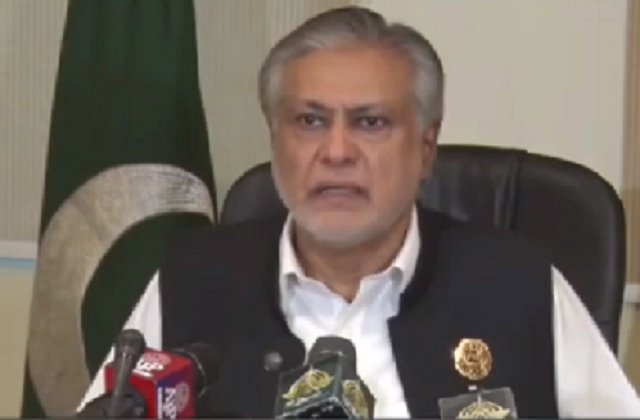Dar’s dilemma: challenges on external front persist
Lower imports may have cut deficit, but they have adverse implications for industrial production

Ishaq Dar’s re-entry at the helm of economic and financial decision-making was expected to result in not only a strong recovery of Pakistani rupee, but also a reduction in the exchange rate volatility.
Several pundits expected the rupee-dollar exchange rate to fall below 200 and ultimately reduce currency market speculation that often leads to large volatility in the exchange rate.
Ishaq Dar is known for his strong-arm tactics, which were essential for keeping the nominal value of the rupee in his previous stint as finance minister. It was expected he would continue to do the same. Unfortunately, he has not yet been able to achieve what was expected of him at the start of his current tenure.
One of the biggest challenges that Pakistan faces, which leads to the recurring volatility in exchange rate, is the balance of payments crisis. It is mostly due to the burgeoning trade deficit, which often follows a period of relatively high consumption-driven economic growth.
Increase in imports outperforms the increase in exports, while other sources of dollar inflows such as remittances and foreign direct investment (FDI) are not sufficient to counter the increasing trade deficit. This causes higher dollar outflows compared to the dollar inflows, eventually resulting in depreciation of the rupee. The government then intervenes in the currency market, often leading to a fall in the meagre foreign exchange reserves.
The low level of reserves indicates the inability of the government to meet its external debt obligations, increasing vulnerability on the external front. Unfortunately, this crisis recurs every few years and the only option to come out of the crisis is to resort to the IMF.
Stopgap measures, which include import restrictions and desperate measures to generate more government revenue, are often ineffective in achieving their outcome. Policymakers have often failed to adopt structural reforms that can help escape from this vicious trap. Long-term goals are sacrificed in favour of short-sighted abrupt measures to curtail the impact of balance of payments crisis.
According to the trade statistics published by the Pakistan Bureau of Statistics (PBS) for September 2022, exports have slightly increased by 1.54% year-on-year while imports have declined by 18.53%. Total exports in the first three months of FY23 have increased by 2.62% year-on-year while imports have declined by 12.37%.
Exports have continued to increase year-on-year across major categories, although the magnitude is not large. Some products that have witnessed major increases include fish and fish preparations, meat and meat preparations, vegetables, knitwear, tents, canvas and tarpaulins, footballs, leather footwear and pharmaceutical products.
There is a decline in exports of Basmati rice, bed wear, towels, plastic material and cement.
Considering imports of major commodities, a significant drop is reported in imports of machinery, transport items, textile products, agricultural and other chemicals as well as metal. This is indeed disconcerting.
Imports of textile machinery have decreased 36.7% year-on-year in the first quarter of FY23 and those of office machinery are down 53.6%. This will clearly not only have a negative impact on production capacities within the country but also on the productivity levels. Imports of new machinery and equipment can help to expand production as well as allow producers to improve their technological capabilities.
Imports of both completely built-up units and completely or semi-knocked down units have decreased by more than 38.5%, suggesting a fall in the production of automobiles in the country. Furthermore, the textile industry is reporting a decline in imports of synthetic fibre, which is an essential input for textile products, while imports of fertilisers and medicinal products have also decreased.
Pakistan is import dependent as it not only relies on imports to fulfill the demand of consumers but also to satisfy the needs of industries. The decrease reported across various indicators in business and economic activity corresponds to the decline in imports.
Although this may have helped reduce the trade deficit, it has adverse implications for industrial production in the country. The lack of productivity creates challenges. Pakistan’s value addition per capita in the manufacturing sector lags behind many of its similar-sized regional neighbours.
Its exports as a percentage of GDP are low and the lack of sophistication in the export bundle indicates that exports are limited primarily to the low value-added goods. Policymakers focus mainly on imposing tariffs, while the regulations involving technical non-tariff measures are limited. This often leads to imports of low-quality goods sold at higher prices in the domestic market.
In essence, the result is the lack of competitiveness in the goods produced in Pakistan. With alternatives for imports being limited, measures to curtail imports through restrictions lead to lower utilisation of the domestic production capacity.
As producers are unable to meet demand in the domestic market, prices of goods increase.
Furthermore, imports may flow into the country through informal channels, which increases the shortage of dollars in the currency market. Any structural adjustment must focus on improving the levels of productivity and in turn competitiveness of domestic producers.
The writer is the Assistant Professor of Economics and Research Fellow at CBER, Institute of Business Administration, Karachi
Published in The Express Tribune, November 7th, 2022.
Like Business on Facebook, follow @TribuneBiz on Twitter to stay informed and join in the conversation.



















COMMENTS
Comments are moderated and generally will be posted if they are on-topic and not abusive.
For more information, please see our Comments FAQ